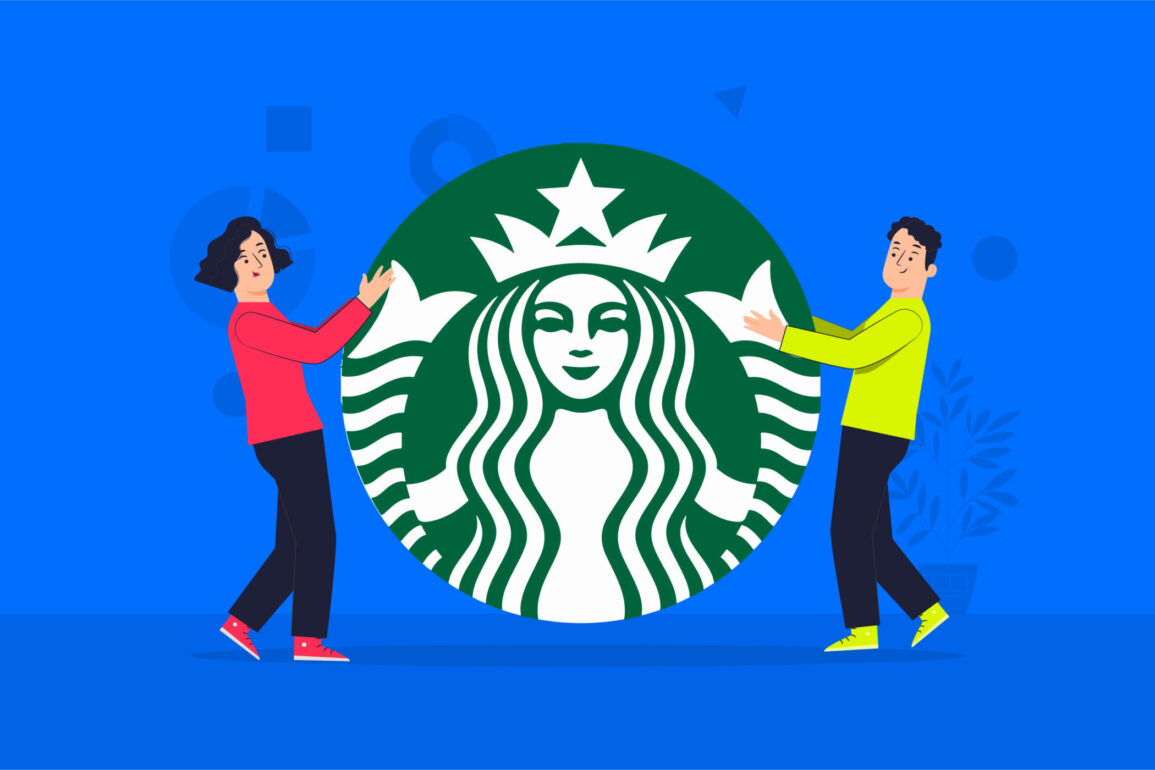Starbucks brand positioning strategy, segmentation, targeting, and marketing

The Starbucks brand positioning strategy is an excellent example of how companies in virtually any industry can become giants with the right branding. Brand positioning captures a place in your customer’s mind as the ideal solution to a specific problem.
Through careful positioning, Starbucks has created a name for itself as a company committed to nurturing the human spirit, community experiences, and protecting the planet.
More than just a collection of coffee shops, Starbucks resonates with its target audience as a leader in fresh, trendy, and convenient experiences. It’s almost more of a lifestyle brand than a coffee vendor.
Starbucks’ approach to brand positioning shines through virtually everything the company does, from how it interacts with its target audience and market segments to its high-quality products.
Perhaps most importantly, the Starbucks marketing strategy is heavily guided by the company’s quest to become the number one coffee company in the minds of its audience.
Today, we will take a closer look at the components of the Starbucks brand position strategy and how the organization has effectively become the biggest coffee chain in the world.
An introduction to Starbucks brand positioning
To start our exploration into the Starbucks brand positioning strategy, let’s take a close look at the origins and evolution of the brand. Starbucks is an American multinational chain of coffee houses and coffee bean roasting services headquartered in Seattle.
As of 2021, the company has more than 33 thousand stores located across 80 countries. Today, the organization is credited with inspiring the “second wave of coffee culture.” In other words, the brand has effectively transformed the way we think about consuming coffee.
Starbucks was founded originally in 1971 by Gordon Bowker, Zev Seigl, and Jerry Baldwin. During this time, many Americans were unhappy with their coffee consumption experience.
Many felt most coffees available on the market were made with cheap beans (usually Robusta), and coffee beans sold in supermarkets often failed to deliver an excellent taste.
At the same time, people were also becoming more health and planet conscious. There was a growing demand in the coffee market to create a product that not only appealed to consumers’ taste buds but also aligned with their growing values of health and wellness.
Starbucks’ founders decided to position their new coffee company as a provider of naturally processed, authentic coffee beverages to those looking for a new experience in the coffee market.
What is Starbucks’ positioning strategy?
When Starbucks first began, the company was focused on a relatively niche segment of customers, including gourmet coffee lovers and those looking to consume their own beans at home.
Over time, as the coffee culture evolved, Starbucks transformed with it, focusing on creating convenient, comfortable experiences for consumers looking for a way to enhance their lifestyles.
Although Starbucks maintained a commitment to the production of high-quality coffee over the years, its positioning strategy became more customer-focused. In other words, they concentrated on giving customers not just the products they needed but the experiences they were lacking.
The company has developed its reputation through the creation of experiences that align with values of social commitment, environmental protection, and store ambiance.
When the Starbucks company was sold to Howard Schultz in the 1980s, he used his experiences with coffee bean stores in Italy to reimagine the structure of Starbucks, expanding into a wider range of drinks and foods.
The goal of the company, however, remained focused on creating an environment where people could relax, socialize, and enjoy great food and beverages. Each Starbucks café includes friendly baristas who serve customers and prepare items according to the needs of clients at the moment.
All Starbucks locations have a menu board providing insights into the ingredients of nutritional values of products, so consumers can make educated decisions. Plus, Starbucks allows consumers to customize their coffee beverages and other products to their specific needs.
The Starbucks positioning strategy goes beyond high-quality coffee to promise different segments access to a consistent, reliable, and friendly experience designed to nourish the human spirit.
What is the brand strategy of Starbucks? Core elements
Highly rated by coffee lovers around the world, Starbucks has become one of the world’s biggest companies thanks to its compelling brand strategy. Not only is the organization constantly looking for new ways to serve its audience, but it’s driven by a consistent set of values.
The company’s commitment to delivering on its brand promise has created consistent loyalty among its patrons.
In fact, the core values of the Starbucks brand have helped the organization to outshine countless other competitors. Unlike other organizations, Starbucks focuses on supporting its community with ethical hiring practices and convenient consumption opportunities for every consumer.
It also commits to protecting the environment by adopting the LEED approach to structuring buildings, recycling coffee grounds, and giving back to the environment.
Starbucks brand promise
Starbucks promises to deliver an experience focused on the betterment of the planet and the people it serves. The company believes building a successful business is about more than just making a profit. It feels it can and should have a positive impact on the world around it.
The aspiration of the brand is to be a people-positive company, investing in humanity and the welfare of the people it connects with. It works closely with partners and coffee farmers around the world to ensure ethical practices are adhered to and serves its customers with convenient experiences.
Additionally, the company strives to be resource positive, which basically means it wants to give back more than it takes from the planet. The company is working to replenish more freshwater than it uses, eliminate waste, and minimize its carbon footprint.
Starbucks’ mission statement and values
Starbucks’ mission statement is to “inspire and nurture the human spirit.” The company wants to be more than just a source of great coffee. Its aim in the world is to create better experiences for everyone, whether you’re a remote worker sitting in one of its cafes or a coffee lover.
The Starbucks brand values are:
- To act with courage and challenge the status quo.
- Connecting with communities with respect and transparency.
- Delivering quality in everything they do.
- To constantly improve its performance.
Starbucks visual identity
The visual identity of the Starbucks coffee brand helps to highlight its unique value proposition.
Starting with the Starbucks logo and color palette, we can see a commitment to inspiration. The memorable Starbucks siren on every cup of coffee and branded product reminds us of not just the lure of coffee but the company’s creative nature.
The green and white color palettes used in Starbucks branding strategies convey purity and nourishment; even the cards and apps used in the Starbucks loyalty program showcase the same visual identity.
Starbucks also positions itself as a modern, trendy company by building new stores with a focus on environmental friendliness and comfort.
Every Starbucks environment is built to empower customers. Not only do consumers get free Wi-Fi within the stores, but they also get a relaxing atmosphere, thanks to carefully chosen furniture, music, and the use of ambiance.
Starbucks personality
The Starbucks personality revolves around youthful, sophisticated, and artistic experiences. The company positions itself as a thought leader by speaking with an authoritative tone of voice and providing consumers with all the information they need when purchasing a cup of coffee.
The global brand uses advertisements and social media marketing to draw attention to its customers, making them the champion of its brand. Additionally, Starbucks aims to connect with younger customers with trendy and modern marketing campaigns.
Starbucks market segmentation: The Starbucks target market
In any brand positioning strategy, one of the most important elements a company can focus on is its target audience. To deliver an excellent customer experience, Starbucks commits to regular research into consumers from different countries and backgrounds.
Primarily, the target market of Starbucks is young adults who want to be seen as individuals committed to the conservation of the planet and the future of sustainable growth.
The company wants to make people feel better about themselves, not just through premium coffee drinks but also with the knowledge they’re giving something back to their community.
Starbucks focuses heavily on diversity, creating products and campaigns intended to support those in marginalized communities. The brand actively supports LGBTQ movements and other important social concepts.
As a hip, trendy, and youthful brand, Starbucks primarily appeals to younger audiences, but it also strives to connect with a range of other communities and cultures.
Starbucks geographic segmentation
When Starbucks first launched, it was primarily focused on audiences in the United States, typically in urban areas. At present, Starbucks still focuses on the urban landscape, appearing more frequently in cities, but it has expanded its footprint to locations all around the globe.
Thanks to its global presence, Starbucks has begun to transform the way it serves customers in different countries. While the organization’s core values of community spirit and sustainability are evident all over the world, the products available in various countries may differ.
In the Middle East, the United Kingdom, and the United States, different coffee products are created and promoted to appeal to the taste of specific customers.
Starbucks behavioral segmentation
From a behavioral standpoint, Starbucks positions itself as an enthusiastic and committed brand. It aims to connect with customers on a deeper level, appealing to their specific values and interests, such as global sustainability, good health, and the importance of socialization.
Starbucks aims to appeal to consumers in search of a sense of belonging and community, as well as those with a creative and artistic mindset.
It looks to connect with customers across a range of environments, enabling digital consumers to place a mobile order when they don’t want to come into the store, as well as creating drive-through Starbucks stores.
While Starbucks does sell products for a premium price, it also cultivates loyalty through programs designed to give consumers access to free drinks and other benefits.
Starbucks psychological segmentation
Psychologically, the Starbucks brand positioning strategy aims to place the company as a provider of exceptional experiences for the upper and middle classes. Starbucks appeals to the desire of consumers to be associated with high-quality products, making a difference in the environment.
Its focus on environmental design and healthy food items also appeals to those with specific personal values.
Starbucks appeals to people who identify themselves as extroverted, social, and aspirational people. It’s a lifestyle brand for the adventurer, committed to self-improvement, innovation, and growth.
Meanwhile, the psychotropic variables in the company’s positioning plan ensure it can provide solutions for a wide range of needs, from those interested in coffee to those who prefer herbal beverages and non-traditional drinks.
Key components of Starbucks brand positioning
On a fundamental level, Starbucks’ brand positioning is all about community and connections. It aims to inspire and nourish its customers through excellent products and meaningful experiences.
While the marketing strategy of Starbucks may have evolved over the years, with new campaigns and strategies, the brand has retained a relatively consistent image.
Ever since making the transition from a “gourmet coffee” brand into a lifestyle brand, Starbucks has placed its consumer at the center of all of its decisions. Here are some of the core components we can see throughout Starbucks’ brand positioning strategy.
1. Selling experiences (not just coffee)
First and foremost, Starbucks positions itself as an experience brand, not just a coffee company.
It aims to appeal to the deepest needs of its consumers for community and connection. When the brand was sold to Howard Schultz in the 80s, he visited Italy (Milan) and found that virtually every street in the city had its own coffee bar.
Not only did these bars sell exceptional beverages, but they focused on delivering amazing experiences, greeting customers by name in a cheerful environment. The baristas established a camaraderie and rapport with their customers, which made them feel appreciated and respected.
As Howard observed more coffee bars, he listened to the types of music being played, the environment available to consumers, and how customers interacted in the spaces. He realized these places offered an environment of comfort and community he wanted to replicate in his own stores.
2. Building relationships
Starbucks focuses heavily on earning the loyalty and commitment of its customers.
The company appeals to its customers’ values, delivering valuable experiences and offering convenience. Their commitment to the community involves ensuring every barista treats customers with care and respect, regardless of their job title, race, gender, or sexual orientation.
The Starbucks “open door” policy also ensures consumers can enter the environment at any time and feel as though they’re experiencing being home away from home.
At the same time, the company ensures it can effectively serve customers regardless of their needs with mobile orders, drive-through locations, and even partnerships with supermarkets.
Another core component of Starbucks’ commitment to building relationships is placing its consumer at the heart of its marketing and branding strategy. It champions user-generated content on social media, delivers loyalty programs to consumers, and allows customers to create their own drinks.
3. Attention to detail
Attention to detail is an important component in the Starbucks brand positioning strategy. Visit a Starbucks store, and you’ll notice everything has been carefully designed to deliver the best experience.
Baristas use the best-quality equipment and tools to ensure they’re producing amazing products. Music is carefully chosen to produce the right ambiance.
When developing the initial Starbucks stores, Howard Schultz even paid close attention to the aroma customers would encounter when they visited a location. He didn’t allow associates to use perfumes, as the beans would absorb the odor, and he even banned smoking.
The little details present throughout the Starbucks customer experience help to ensure consumers continue to get a relaxing, comforting environment whenever they interact with the brand. Baristas are even trained in the art of having conversations with customers to make them feel more at ease.
4. Speed and convenience
Starbucks aims to solve a number of pain points for its customers, ranging from the issues they might face with ordering coffee to getting their products quickly. Baristas are trained to the highest standards to ensure they can prepare amazing drinks quickly.
Additionally, all Starbucks locations include detailed menus to help customers choose the right product.
Consumers also have the freedom to choose how they place their orders.
They can request items in advance to ensure the workers have them ready to pick up when they’re ready to go. Mobile orders and drive-through options are available, and Starbucks even works with delivery companies around the world to send products direct to their customers.
Starbucks’ commitment to speed helped the company to draw in a wider range of consumers beyond those looking for a relaxing, in-house experience. Now the company appeals to professionals struggling with tight deadlines and hectic schedules too.
5. Quality products
Elements of the original Starbucks vision still shine through in the company’s brand positioning strategy today. Initially, Starbucks was heavily committed to providing consumers with excellent coffee at a time when quality beans were difficult to come by.
As such, the company has consistently partnered with farmers across the globe to ensure they can always access exceptional products. Starbucks beans are roasted in a variety of styles to appeal to different tastes, and the company is constantly expanding its menu to feature more items.
Even the food options on the Starbucks menu and the merchandise customers can buy have been carefully chosen to adhere to the company’s unique image. Starbucks’ careful production strategy ensures its products are associated with quality and validates its premium pricing.
6. Ethics and sustainability
Finally, Starbucks consistently commits to making the world a better place. The company ensures its commitment to premium quality doesn’t negatively impact the earth. The brand consistently commits to giving back to its communities and protecting the planet through sustainable and ethical practices.
The brand actively ensures it can hire a wide and diverse range of people from different backgrounds and supports cultural movements on a regular basis. It also carefully chooses how to produce its products and build its stores based on strategies to reduce its impact on the planet.
This commitment to sustainability helps to separate Starbucks from other coffee companies that may cut corners in order to keep prices low. By providing a sustainable experience, Starbucks ensures customers can feel good about the products they’re buying.
Learning from the Starbucks positioning strategy
The Starbucks brand positioning strategy has helped the global company to stand out as a leader in an extremely cluttered marketplace.
Despite countless other coffee companies and brands emerging throughout the years, Starbucks has retained the loyalty of its target audience by positioning itself as an entity committed to nourishment and inspiration.
The Starbucks positioning strategy shows us that even if a company sells products at a higher price than its competitors, it can achieve success by resonating with its customer base. Starbucks consistently learns from its target audience and adapts to their needs.
Fabrik: A branding agency for our times.





















